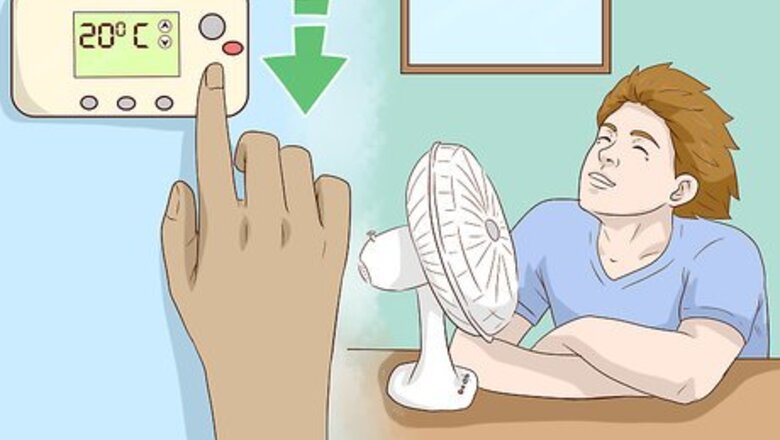
views
Making Lifestyle Changes
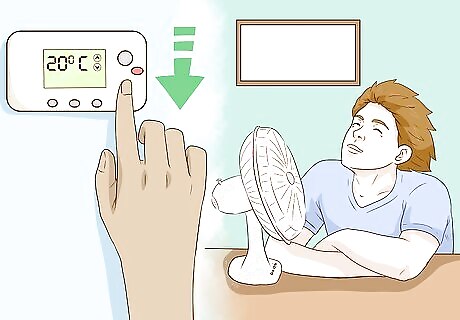
Lower the room temperature or use a fan to cool off. Sweat is the natural reaction that your body has to becoming overheated, so staying cool is the simplest way to stop sweating. Turn down the thermostat to make your space cooler, if you can. You can also use a fan to stay cool. For example, keep a fan at your workstation to blow on your face. When you're on the go, you can take a portable fan. This allows you to blow cool air on your face, even on the hottest of days.

Use an astringent containing tannic acid. After washing your face, apply the astringent to a cotton ball or pad, then dab it over your face. Pay special attention to your temples and forehead near the hairline. You can then continue your skincare routine. You can use the astringent in the morning and evening. If your skin becomes irritated, reduce or discontinue use. You can find an astringent over-the-counter at a drug store or online. Check the ingredient list for tannins. For example, witch hazel is a common astringent that contains tannins.
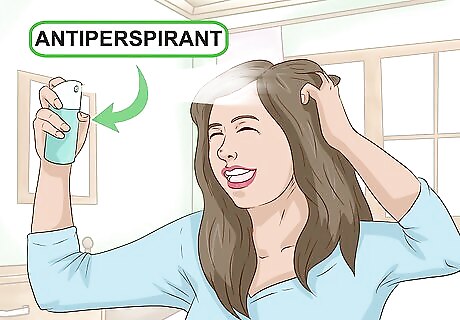
Apply an antiperspirant to your scalp, temples and upper forehead. It will temporarily block your sweat glands from producing sweat. Most people apply antiperspirant at night before bed. However, for facial sweating you may prefer to apply it in the morning after washing your face. Don't get the antiperspirant in your eyes, nose, or mouth. You may want to cover the center of your face when you apply the product to protect it, such as with a towel. Talk to your doctor before using an antiperspirant on your face.
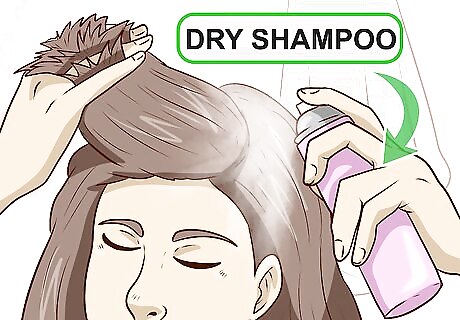
Clean your scalp with a dry shampoo, as needed. Facial sweating often starts along your scalp. A dry shampoo can help you clean your hair and scalp even if you don’t have time to take a shower. It will remove sweat residue and help you stay clean longer. Hold the dry shampoo about 8 inches (20 cm) from your head. Starting at the front of your part, spray 2 in (5.1 cm) sections of your hair, moving from your hairline to the nape of your neck. Massage the dry shampoo to evenly distribute it. You can carry dry shampoo with you throughout the day for touch-ups. This helps manage your excessive facial sweating. If you get extra sweaty during exercise, you might carry the dry shampoo in your gym bag.
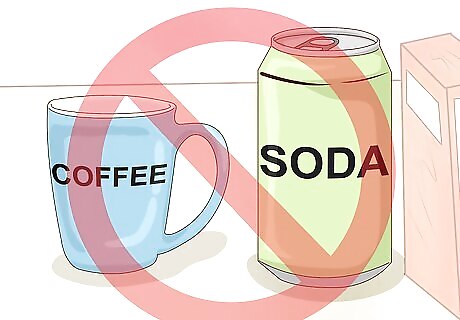
Avoid caffeine to reduce sweating. Caffeine is a common culprit behind excessive sweating, and it can make your sweat smell worse. Skip coffee, soda, and caffeinated tea if you want your face to stay dry. If you love coffee, you could try switching to decaffeinated coffee. Avoid hot beverages when you’re sweating. Drink 8 cups (1,900 ml) of water a day to stay hydrated throughout the day.
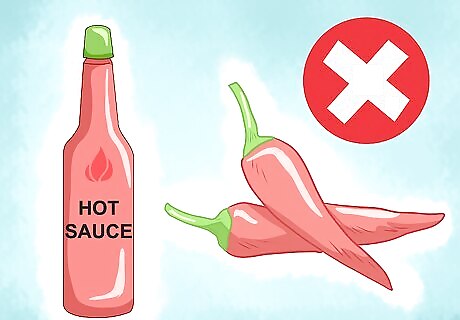
Cut out spicy foods, as they can increase sweating. Spicy foods can make you sweat more. Additionally, they can intensify the smell of your sweat. Avoiding these foods is an easy way to limit how much sweat your body produces. Stay away from dishes that contain peppers, including pepper sauces like harissa and sriracha. Even black pepper adds spice. Instead, look for dishes that are seasoned with herbs like basil, thyme, or rosemary.
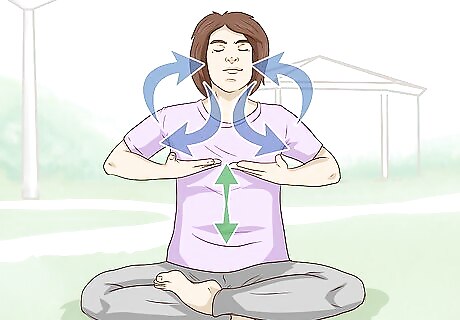
Engage in relaxation techniques to help manage stress sweating. You can do your relaxation techniques to help you stay calm during moments you’re more likely to sweat. For example, you might use a relaxation technique before giving a big presentation at work. Here are some great ways to relax: Meditate to calm your mind and lower your heart rate. This can help you calm down before a big meeting or after an upsetting situation occurs. Do yoga daily to keep your stress levels under control. Start your day with a short yoga practice, or use it to calm down after work. Over time, it will help you maintain a calm demeanor. Do breathing exercises to calm down when you feel stressed. For example, you can use them to calm down in traffic or just before you give a presentation.
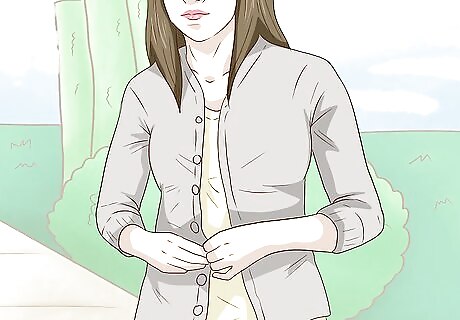
Dress in layers so that you can remove some. This will help you manage your sweat while at work or school. You can remove your outer layers to cool down before you start sweating. For example, wear a cardigan or blazer that you can remove.
Seeking Medical Help
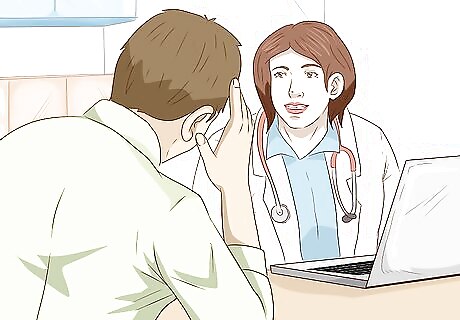
Visit your doctor to find out the cause of your excessive sweating. Potential causes for excess sweating include anxiety, a medical condition, or medication, as sweating can be a side effect. Your doctor will review your symptoms, medical history, and the medicines you’re taking. They may decide to prescribe treatment, or they may refer you to a dermatologist. Bring a list of all medications you are prescribed and are taking. If you have a family history of excessive sweating, share this with your doctor.

Consider a prescription glycopyrrolate cream as the easiest option. You can apply the cream in the morning or evening just like a moisturizer. However, you should avoid applying it around your eyes, nose, and mouth. After you apply the cream, don’t wash your face for 3-4 hours. Although you can use the cream twice a day, you may prefer to use it just in the evening. Common side effects include dry mouth and throat, but no serious side effects are known. Follow all of the directions on the cream.
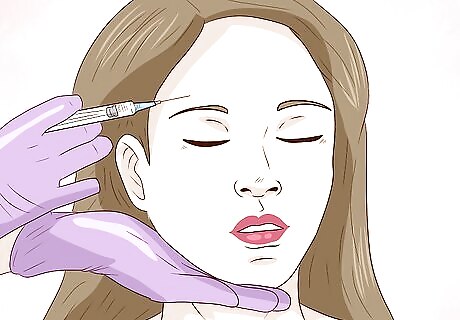
Get botox injections for 6-12 months of relief. Botox is very effective in limiting sweat production, including on your face. Although the injections can make you uncomfortable, the doctor will numb your face with ice or an anesthetic. They will then make several injections around your face and scalp. The effects of the botox last 6-12 months, after which you can decide to have another round of injections. Follow all of your doctor’s instructions. As a side effect, Botox can make other muscles around the injection area feel numb. Although they should eventually regain feeling, you should tell your doctor if this happens. In some cases, Botox can spread into other facial muscles and make your face appear asymmetrical. However, this can usually be fixed by doing another injection to even it out.
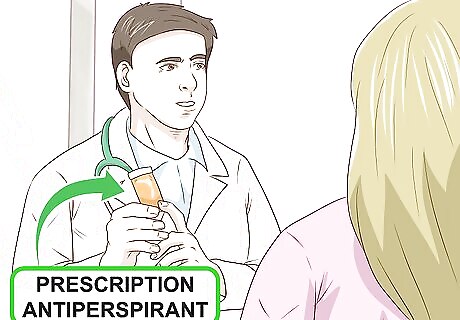
Get a prescription antiperspirant. A prescription antiperspirant is stronger than those available over-the-counter. They contain an aluminum chloride that helps limit your body’s ability to sweat. Although you can use it on your face, you should keep it out of your eyes, nose, and mouth. Follow the directions on the label. Prescription antiperspirant can cause skin and eye irritation. Discontinue use and see your doctor if you experience an adverse reaction.

Ask your doctor if an oral anticholinergic is right for you. This medication can prevent excessive sweating by blocking the chemicals in your body that communicate with your nerves. However, this medicine comes with side effects, such as blurred vision, constipation, and dry mouth, that make it more appropriate for short-term use. Your doctor may prescribe it if you experience troublesome sweating in social situations, allowing you to take a pill on an as needed basis. For example, you might take the medicine on days you have an important work meeting that could trigger sweating.
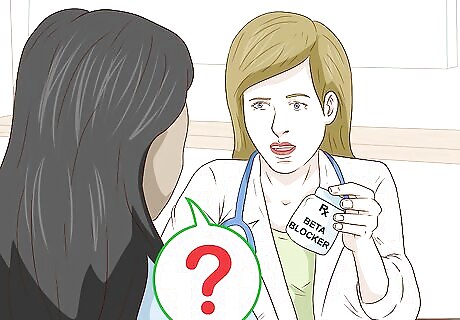
Ask your doctor about beta blockers or calcium channel blockers. Beta blockers and calcium channel blockers can help prevent sweat, depending on what's causing your excessive sweating. Talk to your doctor to see if they are the right choice for you. These medications aren't right for everyone, and they can cause side effects. Common side effects of beta blockers include fatigue, weight gain, and cold hands and feet. Common side effects of calcium channel blockers include headache, dizziness, drowsiness, constipation, nausea, flushing, rash, palpitations, and swelling of your hands and feet.
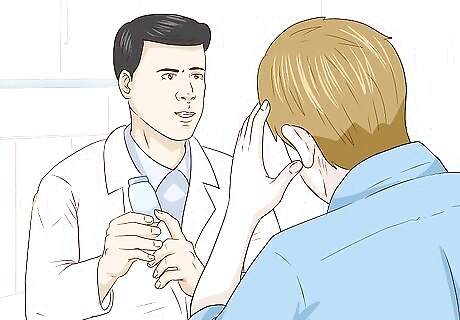
Talk to your doctor about antidepressants for stress sweating. Antidepressants can also decrease sweating, but they’re most effective for people whose sweating is caused by anxiety. Since antidepressants can cause serious side effects, your doctor will likely recommend other options first. Common side effects include nausea, blurred vision, insomnia, agitation, restlessness, anxiety, constipation, dizziness, dry mouth, weight gain, and sexual issues. Follow all of your doctor’s directions when taking the medication.
Keeping Makeup in Place
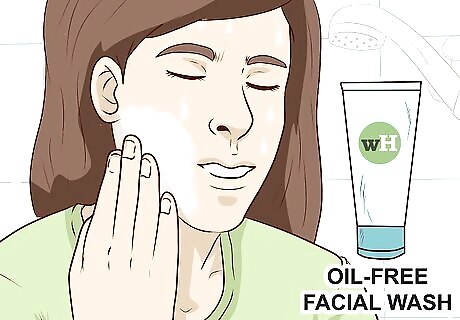
Cleanse with an oil-free product before applying makeup. Choose a face wash that’s labeled for your skin type. Apply a dime-sized amount to your hands, then massage into your face. Finally, rinse with a splash of cool water. Avoiding oil is important, as the oils in makeup can react with oils left on your skin. This makes it more likely that your makeup will come off.

Follow with an oil-free moisturizer. This helps keep your skin soft and smooth without leaving an oily residue. Start with a pea-sized amount, adding more moisturizer, if necessary. Check the label to make sure the moisturizer is labeled as oil-free. Opt for a lightweight formula, especially during hot weather.
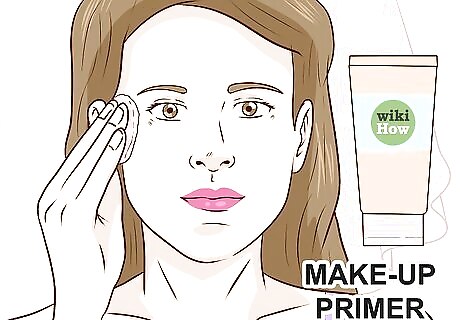
Use a primer to extend the life of your makeup. Primer helps your makeup stay in place longer, as well as creates an even skin tone. Start applying the primer on your nose, working your way outwards. Continue to apply primer until your entire face is covered. You can then apply your makeup as usual.
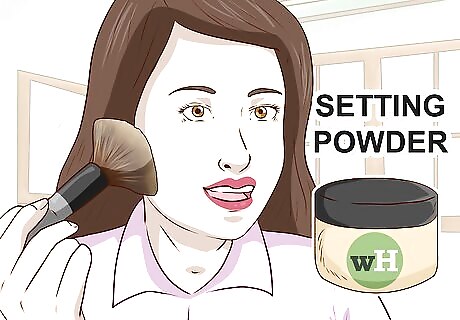
Complete your application with a setting powder and spray. After you apply the rest of your makeup, use a large powder brush to apply a setting powder over your face. Finally, spritz a setting spray over your makeup application. This will hold your makeup in place throughout the day. Choose a spray that doesn’t contain alcohol, as it can dry out your makeup and cause cracks.
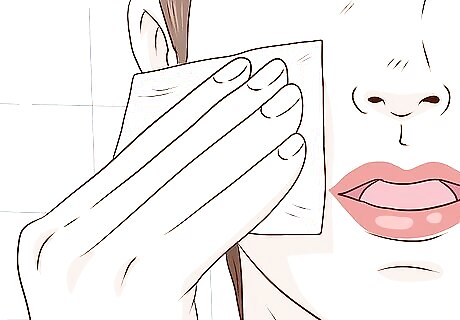
Dab away sweat with a clean towel or tissue before doing touch-ups. When you do sweat, blot it away as soon as you can. You can then touch-up your makeup, as necessary. If you touch-up your makeup without blotting away the sweat, your makeup will look caked-on.

Reapply powder as necessary. Use a brush to apply a light layer of powder over your face. You can do this several times a day. You may want to touch-up your foundation, blush, or eye makeup before applying powder.











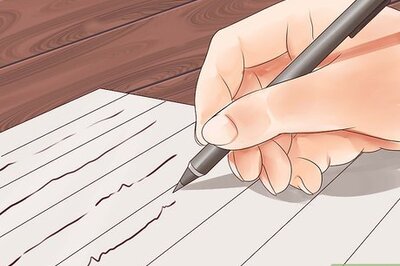




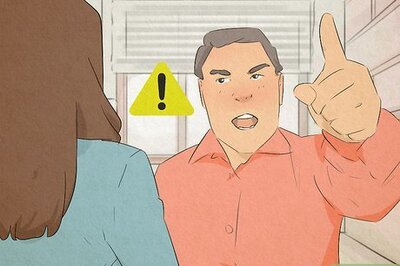



Comments
0 comment